
- Subject:
- Arts and Humanities
- Material Type:
- Lesson Plan
- Author:
- Skyler Smyres
- Tamara Crow
- Date Added:
- 01/15/2018


The attached close reading activities go with the novel The Call of the Wild by Jack London and are aligned to 9-12 CC ELA standards and focus on analyzing word choices, interpreting literary techniques, and determining themes. Full Text: https://www.gutenberg.org/files/215/215-h/215-h.htm Audio Link: https://www.youtube.com/playlist?list=PLVuRdoIItQC9ER0sqT4CTUV1uu7pi1JDK
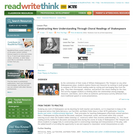
After reading "The Tempest" or any other play by William Shakespeare, students work in small groups to plan, compose, and perform a choral reading based on a character or theme.
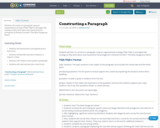
Students will construct a paragraph using an organizational strategy (TIQA-TIQA-C) and apply that strategy as they write about and characterize the protagonist in Richard Connell's "The Most Dangerous Game."
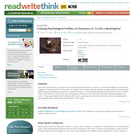
Students explore the motivation behind characters' actions in "To Kill A Mockingbird" by creating psychological profiles for characters from the novel.
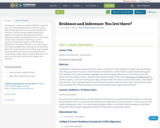
Developed for students in advanced ESL/ELL classes as well as for native English speakers with low reading skills, this group lesson focuses on the formulation of inferences, and the relevant explicit details which support each inference. The initial presentation highlights the skill of making inferences in a real-world context, then transitions to the literary context. Students read selected chapters of The House on Mango Street, by Sandra Cisneros, a core text in many junior high and high school curricula across the United States. The students read out loud. Then, in groups they formulate inferences based on what they have read. Using sentence strips, they summarize the inference as well as cite the textual details which support each inference.

Students will read and analyze a short story from the Southern Gothic genre entitled "The Life you Save May be Your Own" by Flannery O'Conner. They will continue to explore the ideas of human compassion and morality by examining the apparent lack of compassion in the characters of Mr. Shiftlet and the old woman, Lucynell Crater. Students will use close reading strategies to identify examples of indirect characterization that contribute to their analysis of these two central characters in the text. Image source: "Mockingbird" by skeeze on Pixabay.com.

This is a project for the play Fences by August Wilson.

In Module 10.1, students engage with literature and nonfiction texts and explore how complex characters develop through their interactions with each other, and how these interactions develop central ideas such as parental and communal expectations, self-perception and performance, and competition and learning from mistakes.
Find the rest of the EngageNY ELA resources at https://archive.org/details/engageny-ela-archive .

In this lesson, students will read and analyze "The Interlopers" by Saki (H. H. Munro). Lesson 1 from the Author's Craft unit focuses primarily on character. Students will examine how the motivations of Georg and Ulrich drive the plot, develop the theme, and enhance the irony. The lesson requires student to collect evidence, discuss, and complete a writing assignment. It also offers additional stories to extend the lesson. Image source: "Forest" by flo222 on Pixabay.com.

In this lesson students will read and analyze “The Flowers” by Alice Walker. Lesson 2 from the Author’s Craft unit focuses on diction. Students will examine how Walker’s word choice creates tonal shifts in the story that support the theme. The lesson requires student to collect evidence, discuss, and complete a writing assignment in which they continue the story while using diction to maintain the tone. Image source: "Rose" by Kapa65 on Pixabay.com.

In this module, students will read, discuss, and analyze contemporary and classic texts, focusing on how complex characters develop through interactions with one another and how authors structure text to accomplish that development. There will be a strong emphasis on reading closely and responding to text dependent questions, annotating text, and developing academic vocabulary in context.
Find the rest of the EngageNY ELA resources at https://archive.org/details/engageny-ela-archive .

In this module, students engage with literature and nonfiction texts that develop central ideas of guilt, obsession, and madness, among others. Building on work with evidence-based analysis and debate in Module 1, students will produce evidence-based claims to analyze the development of central ideas and text structure. Students will develop and strengthen their writing by revising and editing, and refine their speaking and listening skills through discussion-based assessments.
Find the rest of the EngageNY ELA resources at https://archive.org/details/engageny-ela-archive .
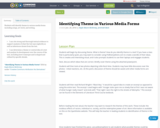
Students will identify theme in various media forms including songs, art-work, and writing.
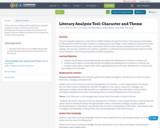
In this resource, students will be asked to use a graphic organizer in order to identify and track the development of theme and character in a literary text. Students will use evidence from the text to construct an evidence based response.

Module over W.W. Jacobs "The Monkey's Paw"
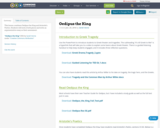
This lesson combines Oedipus the King and Aristotle's Poetics. Students will look at both pieces and write an argumentative essay as their assessment.
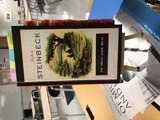
Activity Description: This activity is actually three different discussion-based activities to be used in a station rotation discussion day format. It does require some prework with the double journal note-taking graphic organizer included in the resources. This station rotation discussion format could be used with each chapter, a grouping of chapters, or at the end of the book. If you are encompassing the entire book, this activity will most likely take several days.Time needed for activity: 30-45 (10ish minutes per station)Resources needed for activity: student notes using the double journal note-taking graphic organizer (linked here and as a PDF in the resources) paper for timelines or internet access to https://time.graphics/ or another online timeline maker, internet access to an online discussion tool like https://pinup.com/ or a discussion forum on your LMS.Assessment strategies: See the attached rubrics for possible assessment methods.

An OER Anthology of Earlier American Literature to 1899
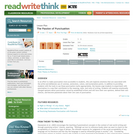
Using published writers' texts and students' own writing, this unit explores emotions that are associated with the artful and deliberate use of commas, semicolons, colons, and exclamation points (end-stop marks of punctuation).